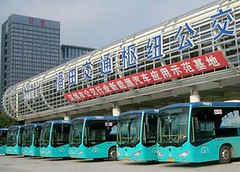 新研究顯示,若考量發電廠產生電力的因素之後,中國的電動汽車造成的有害懸浮微粒污染,比汽油車輛還要更高。
新研究顯示,若考量發電廠產生電力的因素之後,中國的電動汽車造成的有害懸浮微粒污染,比汽油車輛還要更高。
中國有85%的電力來源為化石燃料,其中大約90%是煤碳。中國與美國的研究團隊發現,為了替電動車供電的發電過程,其所產生的細懸浮微粒(PM2.5)的比率,高於汽油車。
美國田納西州立大學土木與環境工程系助理教授 Chris Cherry 以及他的研究生 Shuguang Ji 分析了中國34個主要城市中,五種不同交通工具的排放物對環境健康的影響,特別是危險的細懸浮微粒。
Cherry 說,「一般的假設是,與傳統車輛相較,電動車對空氣品質與健康的負面影響是較低的。」
 「藉著比較所使用車輛種類的排放以及人們實際所暴露的排放,我們的發現挑戰了上述觀點,」他說,「過去的研究只透過比較排放因子或是溫室氣體排放來評估環境受到的影響。」
「藉著比較所使用車輛種類的排放以及人們實際所暴露的排放,我們的發現挑戰了上述觀點,」他說,「過去的研究只透過比較排放因子或是溫室氣體排放來評估環境受到的影響。」
中國電動車與傳統汽車數量的比例約為2:1。史上電動機車替代燃油車輛最多的地方發生在中國,過去10年間,中國市場售出了超過1億輛電動機車,比所有其他國家總合還要高。
Cherry 說,對電動車而言,排放是發生在產生電力的地方,而不是車輛使用的地方。
研究者利用文獻中整體排放數據以及排放率,評估了中國五種車輛排放對健康的影響,並且計算人們所吸入不同車輛排放的比例。五種車輛分別是汽油小客車、柴油小客車、柴油巴士、電動機車(e-bike)以及電動小客車(e-car)。
研究發現電動小客車的影響比柴油客車要低,但是與柴油巴士相當。已人均每公里駕駛里程來看,電動機車對環境健康的影響是最低的。
 這項研究所測量的空氣汙染物為可吸入的微粒,包含酸性物質、有機化合物、金屬以及土壤或灰塵顆粒。燃燒石化燃料也會產生這些微粒。
這項研究所測量的空氣汙染物為可吸入的微粒,包含酸性物質、有機化合物、金屬以及土壤或灰塵顆粒。燃燒石化燃料也會產生這些微粒。
Cherry 表示,這項研究凸顯了在評估電動車對環境健康影響以及將空氣污染源移出城市時,考量暴露與排放源距人口遠近的重要性。他說,以電動車而言,大約有一半的城市排放量是被農村人口所吸收。
Electric vehicles in China cause more harmful particulate matter pollution than gasoline-fueled cars, when emissions from the generating stations that power them is factored in, new research shows.
In China, 85 percent of electricity production is from fossil fuels, and about 90 percent of that is from coal. The generation of electricity to operate EVs emits fine particles at a much higher rate than petrol-powered vehicles, finds a team of researchers from the United States and China.
Chris Cherry, assistant professor in civil and environmental engineering at the University of Tennessee, and graduate student Shuguang Ji, analyzed the emissions and environmental health impacts of five vehicle technologies in 34 major Chinese cities, focusing on dangerous fine particles.
"An implicit assumption has been that air quality and health impacts are lower for electric vehicles than for conventional vehicles," Cherry said.
"Our findings challenge that by comparing what is emitted by vehicle use to what people are actually exposed to," he said. "Prior studies have only examined environmental impacts by comparing emission factors or greenhouse gas emissions."
Electric vehicles in China outnumber conventional vehicles 2:1. E-bikes in China are the single largest adoption of alternative fuel vehicles in history, with over 100 million vehicles purchased in the past decade, more than all other countries combined.
For electric vehicles, says Cherry, combustion emissions occur where electricity to power them is generated rather than where the vehicle is used.
The researchers estimated health impacts in China using overall emission data and emission rates from literature for five vehicle types - gasoline and diesel cars, diesel buses, e-bikes and e-cars - and then calculated the proportion of emissions inhaled by the population.
The impact of electric cars was found to be lower than diesel cars but equal to diesel buses. E-bikes yielded the lowest environmental health impacts per passenger per kilometer.
The type of air pollution measured for the study - particulate matter - includes acids, organic chemicals, metals, and soil or dust particles. It is also generated through the combustion of fossil fuels.
Cherry said the research highlights the importance of considering exposures and the proximity of emissions to people when evaluating environmental health impacts for electric vehicles and the impact of moving air pollution out of cities. For electric vehicles, about half of the urban emissions are inhaled by rural populations, he said.






